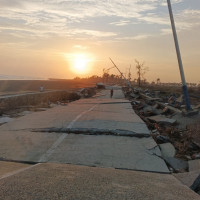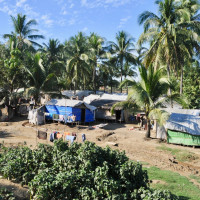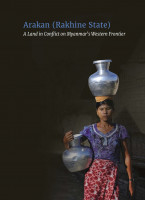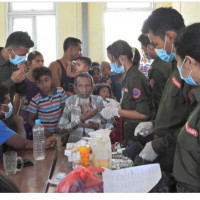Assessing What is Happening in Arakan One month after Cyclone Mocha
Regions
A Myanmar commentary by Border News Agency*
Cyclone Mocha inflicted devastation in Arakan in the midst of a ceasefire between the military State Administration Council and Arakan Army. In this commentary, Border News Agency analyses the impact, how the different authorities responded and the continuing fall-out. In a country in conflict, new paradigms in aid delivery need to be developed through local community, civil society and non-state armed groups if relief and recovery support are to be delivered to the suffering peoples.

Credit: BNA
Non-governmental groups in relief provision
Compared to other parts of the country, the growth of local non-governmental organisations (NGOs) or CSOs in Arakan is relatively late, especially in the areas of emergency relief and humanitarian assistance provision. International NGOs, on the other hand, have mostly focused on the plight of Rohingya in Bangladesh and, to an extent, in Myanmar since the 1990s. Although different kinds of CSOs are functioning at local administrative levels, they are loosely organised and under-resourced, limiting their abilities to provide emergency support while their activities are highly restricted in the context of political repression which they daily face.
The situation reached a turning point with the country’s political opening in 2011 and the outbreak of inter-communal violence in Arakan in 2012. Subsequent events, such as the 2014 floods, Rohingya exodus in 2016-17 and intensified clashes between the AA and Myanmar military from 2018, provided a strong momentum for local NGOs and CSOs to multiply and strengthen. Due, however, to the 2021 military coup, civic space in Arakan faced a challenging security environment. This created division among groups who want to remain neutral by following restrictions imposed by the SAC and those who want to denounce the regime’s legitimacy by cutting off any direct relationship with its officials.
More recently, the authorities also announced that local NGOs and CSOs need to ask for permission from the SAC’s administrative bodies if they want to provide emergency assistance in the cyclone-affected areas. Local organisations, however, find it difficult – or are reluctant – to gain permission from regional authorities of the regime which is leading to delays and an insecure operational context. This directive contrasts with that of the ULA which, to date, has only required aid organisations to notify them about the basic information of their assistance so as to avoid overlapping programmes and to facilitate aid provision in the affected areas.
Currently, there are at least three groups when it comes to the roles of local NGOs and CSOs in emergency relief and recovery provision during the post-cyclone landscape. The first group includes those organisations that redistribute aid from international NGOs and United Nations (UN) agencies. The second category consists of local charity groups that redistribute donations and materials from individuals or organisations inside and outside of the country. And the third group use a mixed approach.
To date, the second group has been able to organise and deliver support better than the other two. However, apart from urban and peri-urban areas, they find that coverage to remote areas remains challenging. Like other organisations, they have their strengths, such the ability to mobilize resources quickly. But they also face challenges, including insufficient financial and material resources, insufficient data, lack of strategic disaster response policies, and questions over area prioritization.
While local NGOs and CSOs face limitations, they are not alone in this, and UN agencies and other international humanitarian organisations have also run into many difficulties. Since the cyclone, there has been resounding criticism over the position taken by the United Nations Office for the Coordination of Humanitarian Affairs (UNOCHA) as it waited for permission from the SAC authorities until it could provide emergency relief to disaster-affected areas. In contrast, many local sources confirmed that the World Food Program (WFP) and the International Committee of the Red Cross (ICRC) provided some humanitarian assistance in both SAC-controlled urban areas and ULA-controlled rural areas, including in Sittwe and Rathedaung townships, a few days after the cyclone.
These delays only worsened the suffering caused by the cyclone. The strike was devastating, and aid received by local communities was far from sufficient. Compounding these difficulties, the SAC issued a directive requiring humanitarian assistance from the UN and other international agencies to be delivered only through their ‘rehabilitation committee’ which consists of serving military officers. This was followed by another announcement requiring humanitarian personnel to travel only if they have obtained permission from the SAC. Such a demand is a clear violation of the core UN humanitarian principles of ‘humanity’, ‘neutrality’, ‘impartiality’ and ‘independence’.
In reality, these key humanitarian principles had already been violated when UNOCHA was unable to provide emergency relief due to its ‘lack of autonomy’ while it waited for a unilateral decision by the SAC. The consequences of this obstruction were reflected in the statement issued by the UN Resident Coordinator and Humanitarian Coordinator (acting) in Myanmar on 14 June:
''Banning access to help needlessly prolongs the suffering of those who are homeless and without food. It increases the risk of food shortages and the risk of diarrheal diseases.''
Presently, there appears little likelihood for these deficiencies to be addressed. In its latest situation report, UNOCHA highlighted the overwhelming funding gap between humanitarian needs and funds available (US$ 333 million versus US$ 21.7 million received so far) as well as the continuing travel and communication constraints in the affected areas.

Credit: BNA
Assistance actions of the two political authorities
Many observers have commented that Cyclone Mocha will have important consequences in military-political relations between the two leading authorities in the state: the SAC and ULA. As a result, some predict that the current de facto ceasefire in Arakan will continue to hold for at least another six months until the end of this year. Equally significant, the cyclone impact also tested the administrative capability of the two authorities, bringing to the surface a clear picture relating to trust and territorial control. In response to this challenge, both authorities showcased their efforts, seeking to show the effectiveness of their actions in undertaking post-cyclone relief and recovery activities.
For its part, the regime authorities usually released photos and videos on their social media platforms which featured soldiers and government staff providing assistance, such as food, clothes and other essential goods. In these reports, however, the SAC scarcely mentioned where assistance is being provided or the amount of assistance and population coverage. Some local sources claimed that they only provided aid to family members of military soldiers and government staff. And even some of them still cannot receive help. Despite providing assistance to the Rohingya displacement camps near Sittwe and populations in other townships, the coverage so far has been a thin layer on the affected communities. By some estimates, the percentage reached is less than five percent of the total affected population.
Equally concerning, there is no visible evidence that the SAC is redistributing emergency assistance received from neighbouring countries, including India, Bangladesh and the members states of ASEAN. This has led to criticism regarding the hierarchy of the transportation system in receiving assistance, especially from India and Bangladesh, questioning why ships from these two countries have been going to Yangon rather than the Sittwe seaport or other feasible harbours in Arakan which are closest to the most needy people. This could be due to problems in infrastructure or the SAC trying to gain political advantage by showing that it is only actor helping people in Rakhine State. In the same way, there are also allegations that the regime authorities are trying to achieve political influence over religious leaders and the general population in the targeted manner by which aid is being used.
The ULA authorities, at the same time, also released photos and videos related to aid provision and rebuilding damaged homes and public infrastructure, such as bridges and roads. In a recent statement from its Facebook page, Cyclone Mocha ERRC said in mid-June that only 30 per cent of the total affected 1.5 million people have been provided with relief supplies, such as shelter and food, and an appeal was made for more support, including water, sanitation, building materials, healthcare and medicine, electricity and other emergency relief items to help livelihood recovery.
In the case of the ULA, the inclusion of the Rohingya community in aid provision is also well-published on social media platforms. But some local sources also said that other ‘double minority’ groups in Arakan, such as Mro, Thet, Khamei and Chin, still had not received any emergency relief in ULA-controlled rural areas of Buthidaung, Ponnagyun, Myebon, Minbya and Ann townships. In reply, responsible officials stated that all double minority groups are included in ULA emergency relief provision, but aid teams have not been able to reach all the affected-areas at the moment. Concrete data on support provided to specific ethnic groups, they said, will be released later.
Recovery activities still stuck
The impact of Cyclone Mocha left almost all towns and villages along its path in ruins and beyond recognition even in the eyes of local people. The most heartbreaking views include destroyed historical landmarks and cultural heritage that it is impossible to put a price on. The rainy season has arrived, and hundreds of thousands of disaster-affected people are still shelterless and living in hopeless conditions.
In contrast with this, the deputy SAC chief, Vice Snr-Gen. Soe Win, said on 14 June during a visit to Sittwe that he was satisfied to see the progress and success of recovery and rehabilitation activities in the disaster-affected areas one month after the cyclone. This view is bitterly rejected by local people. Local media sources claimed that the recovery and reconstruction works carried out by the regime authorities are mostly for government buildings in urban areas. Many damaged schools have still not been repaired in time for the school season starting in June, and other essential public infrastructures, including hospitals, roads and ports, have also been neglected in affected townships within Arakan.
Adding to the hardship, people living in Sittwe complain that they have to bribe government staff to reconnect electricity lines to their houses again. For its part, the ULA has been unable to restore basic infrastructure such as schools and clinics until now, and has concentrated it activities on repairing homes, reservoirs, wells, small roads and bridges in villages in its controlled areas.
With the arrival of the monsoon season, the situation is deeply troubling. As Cyclone Mocha affected towns and villages across extensive areas, there are still many families, even in Sittwe the capital of Rakhine State, who are unable to rebuild their homes before the rains intensify. Instead, they have decided to take refuge in Buddhist monastery compounds. The situation is even worse for people living in remote areas who are trapped by the lack of transportation and face SAC travel restrictions. Farmers, too, are struggling with access to seeds and other farming materials to start a new cycle of planting with the advent of rain. And, for those working as fisherfolk along the Bay of Bengal, the destruction and disappearance of their fishing nets and boats has caused more challenges for survival, and they also face the challenge of rebuilding their houses.
The consequences of this dire situation are producing immense socio-economic and psychological distress among local communities. This has led to an escalating rate of migration from the affected townships, a trend which had already begun to increase following the 2021 coup. Many families and youths from Rathedaung, Ponnagyun, Kyauktaw, Buthidaung and Pauktaw have been selling their homes and other properties in order to be able to migrate to other parts of the country or neighbouring countries such as Thailand, China and Malaysia. Against this backdrop, many observers are warning of the increased possibility of ‘human trafficking’ for illicit business activities in the region, especially for women and girls. Already suffering from the impact of conflict, much of northern Arakan remains in humanitarian crisis.
What needs to be done?
One month after Cyclone Mocha landed, the devasating fall-out is still developing. At the moment, the two political authorities of the SAC and ULA seem to have a basic understanding of the need to avoid another round of fighting while the local population is immersed in humanitarian and recovery needs. The ULA/AA chief, Twan Mrat Naing, recently posted on his social media platform a call for a non-violent resolution to the tensions and dissatisfaction caused by the aid blockade imposed by the SAC. At the same time, the regime authorities are widely criticized for trying to block or delay aid provision through non-governmental and community-based organisations. For this reason, the SAC is widely accused of having military and political interests in prolonging the humanitarian emergency in order to justify and increase their presence on the ground while, under the cover of the cyclone, trying to control and decrease the possibility of another round of ULA/AA operations in the coming months.
Conflict considerations are thus integral part of these humanitarian dimensions. Arakan is a territory adjoining the neighbouring countries of Bangladesh and India, sharing a tri-border region in Paletwa township in modern-day Chin State. Many of these border areas are now under the control of the ULA/AA, and road communications are fairly developed. Unlike Cyclone Nargis, however, which hit the Ayeyarwady Region in lower Myanmar in May 2008, the SAC cannot reach many parts of the Mocha-affected areas, especially those under ULA administration.
For this reason, rather than relying on unilateral decisions made by the SAC, which is waging war and inflicting suffering on civilian lives and property on a daily basis in other parts of the country, humanitarian coordination with the ULA should be considered as a key alternative way for aid delivery. In taking this step, the ULA can be regarded as an ‘armed non-state actor” (ANSA) or ‘non-state armed group’ (NSAG). These are legal and legitimate definitions and actions from the viewpoint of international law in conflict-affected contexts. Records show that humanitarian actors like the ICRC have worked with ANSA movements more than a hundred times around the world to perform effective humanitarian work while acknowledging that such cooperation should mean neither ‘recognition’ nor ‘legitimisation’ of armed actors apart from the humanitarian purpose. In the Myanmar situation, it should also be noted that, since the 2021 coup, the UN General Assembly in New York has continued to recognise the ambassador appointed by the National League for Democracy-led administration before it was ousted by the SAC.
The reality is that Myanmar today is a land in deep crisis, and Cyclone Mocha has added to the suffering in another part of the country. As conflict and national breakdown continues, Myanmar as a state is not unitary. And evidence is mounting that there are other capable and legitimate political centres emerging in different parts of the country. The ULA/AA in Arakan is very clearly one of them. Thus, if aid and relief are to be truly brought to the suffering peoples to help the country in a time of deep emergency, humanitarian responses in the coming months need to be pragmatic and based upon innovative forms of cooperation with de facto authorities such as the ULA and local civil society organisations on the ground. And this is a similar question and aid paradigm that needs to be addressed in other parts of the country until the peoples of Burma/Myanmar find a common path towards sustainable peace, democracy and stability.




